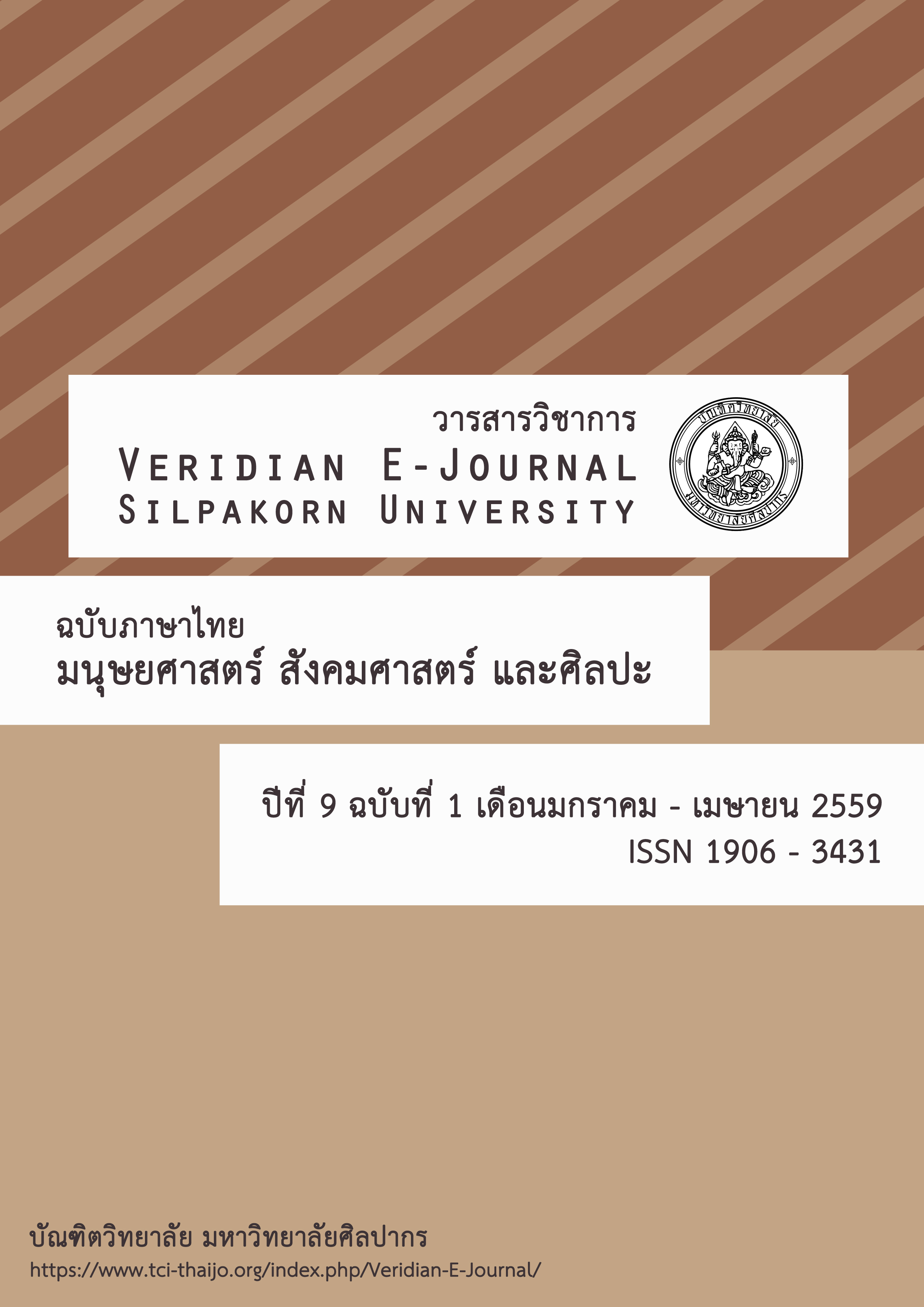แนวปฏิบัติในการบริหารจัดการหลักสูตรเพื่อส่งเสริมการทำวิจัยของครู
Main Article Content
Abstract
บทคัดย่อ
การวิจัยครั้งนี้ใช้ระเบียบวิธีวิจัยทั้งในเชิงปริมาณและเชิงคุณภาพ โดยมีวัตถุประสงค์เพื่อ 1)ทราบขอบเขตการทำวิจัยของครู 2)พัฒนาหลักสูตรฝึกอบรมการทำวิจัยของครู 3)ทราบผลการพัฒนาหลักสูตรฝึกอบรมการทำวิจัยของครู 4)ทราบแนวปฏิบัติในการบริหารจัดการหลักสูตรเพื่อส่งเสริมการทำวิจัยของครู ขั้นตอนในการดำเนินการวิจัยมี 4 ขั้นตอน คือ ขั้นที่ 1 เพื่อหาขอบเขตการทำวิจัยของครู ขั้นที่ 2 เพื่อพัฒนาหลักสูตรฝึกอบรมการทำวิจัยของครู ขั้นที่ 3 เพื่อหาประสิทธิผลหลักสูตรฝึกอบรมการทำวิจัยของครู ขั้นที่ 4 เพื่อหาแนวปฏิบัติในการบริหารจัดการหลักสูตรเพื่อส่งเสริมการทำวิจัยของครู เครื่องมือในการวิจัย คือ 1)แบบวิเคราะห์เนื้อหา 2)แบบสัมภาษณ์กึ่งโครงสร้าง 3)หลักสูตรฝึกอบรมการทำวิจัยของครู 4)แบบประเมินประสิทธิผลของหลักสูตรฝึกอบรมการทำวิจัยของครู กลุ่มตัวอย่างที่ใช้ในการวิจัย คือ ครูสังกัดสำนักงานเขตพื้นที่การศึกษาประถมศึกษาราชบุรีจำนวน 48 คน โดยใช้แผนแบบการทดลองที่แท้จริง (True Experimental Designs) รูปแบบสี่กลุ่มโซโลมอน (The Solomon four – group design)สถิติการวิเคราะห์ข้อมูล คือ ค่ามัชฌิมเลขคณิต (Arithmetic Mean) ส่วนเบี่ยงเบนมาตรฐาน (Standard deviation) การวิเคราะห์ความแปรปรวนสองทาง (Two-way ANOVA) ผลการวิจัย พบว่า
1. ขอบเขตการวิจัยของครูประกอบด้วย 9 ขั้นตอน ดังนี้ ขั้นที่ 1 นำเข้าสู่การอบรม ขั้นที่ 2 การวิเคราะห์กำหนดปัญหาการวิจัย ขั้นที่ 3 การกำหนดวัตถุประสงค์การวิจัย ขั้นที่ 4 การออกแบบการวิจัย ขั้นที่ 5 การเก็บรวบรวมข้อมูล ขั้นที่ 6 การวิเคราะห์ข้อมูล ขั้นที่ 7 การสรุปผล อภิปรายผลและข้อเสนอแนะ ขั้นที่ 8 การเขียนรายงานการวิจัย ขั้นที่ 9 การนำเสนอผลงานวิจัย
2. การพัฒนาหลักสูตรฝึกอบรมการทำวิจัยของครูมี 3 ขั้นตอน ดังนี้ 1) การร่างหลักสูตร 2) การหาคุณภาพหลักสูตร 3) การหาประสิทธิผลของหลักสูตร และหลักสูตรฝึกอบรมการทำวิจัยของครูมี 5 องค์ประกอบ ดังนี้ 1) หลักการและเหตุผลในการสร้างหลักสูตรฝึกอบรม 2) จุดประสงค์ของหลักสูตร 3) เนื้อหาและโครงสร้างของหลักสูตรฝึกอบรมแบ่งเป็นหน่วยฝึกอบรม 4) กิจกรรมฝึกอบรม 5) การประเมินผลหลักสูตร
3. ประสิทธิผลของหลักสูตรฝึกอบรมการทำวิจัยของครู มีผลสัมฤทธิ์อยู่ในระดับมาก ค่ามัชฌิมเลขคณิตเท่ากับ 3.75 ผู้เข้ารับการฝึกอบรมมีความพึงพอใจในระดับมากมีค่ามัชฌิมเลขคณิตเท่ากับ 4.92 ส่วนเบี่ยงเบนมาตรฐานเท่ากับ 0.24 และผลสัมฤทธิ์หลักสูตรเกิดจากกระบวนการฝึกอบรมที่แท้จริง
มีค่านัยสำคัญทางสถิติที่ 0.000
4. แนวปฏิบัติในการบริหารจัดการหลักสูตรเพื่อส่งเสริมการทำวิจัยของครู ประกอบด้วย 3 ด้าน คือ 1. การสร้างหลักสูตรการทำวิจัยของครูที่มีประสิทธิภาพ ประกอบไปด้วย (1)การร่างหลักสูตร (2)การหาคุณภาพ (3)การหาประสิทธิผล 2. การส่งเสริมสนับสนุนการใช้หลักสูตรการทำวิจัยของครูในสถานศึกษา (1)การกำหนดนโยบายและวางแผนงาน (2)การสร้างความตระหนักและแรงจูงใจ (3)การพัฒนาบุคลากร (4)การสนับสนุนปัจจัยต่างๆเพื่ออำนวยความสะดวก 3. การกำกับดูแลคุณภาพการใช้หลักสูตรการทำวิจัยของครู ประกอบไปด้วย (1)การนิเทศการใช้หลักสูตรการทำวิจัยของครู (2)การสรุปผลการใช้หลักสูตรการทำวิจัยของครู (3)การประเมินผลการใช้หลักสูตรการทำวิจัยของครู (4)การสะท้อนผลการใช้หลักสูตรการทำวิจัยของครู
Abstract
This research was designed as a mixed methodology based on qualitative and quantitative research. The research objectives were to 1)determine scope of teacher research, 2)develop the training curriculum of the teacher research, 3)obtain the result from the development of teacher research’s training curriculum and 4) acquire the practical guidelines in curriculum administration for enhancing teacher research. The research comprised 4 procedures as follows; firstly, to findout scope of teacher research, secondly to develop the training curriculum of the teacher research, thirdly to obtain the effectiveness of teacher research’s training curriculum from satisfaction of trainees and knowledge achievement, fourthly to acquire the practical guidelines in curriculum administration for enhancing teacher research. The instruments for collecting the data were a content analysis form, semi-structured interview form, training curriculum of the teacher research, a questionnaire and knowledge achievement test. The sample consisted of 48 teachers from Ratchaburi Primary Educational Service Area Office 1 which employed true experimental designs; the Solomon four – group design. The statistics used for data analysis were frequency, arithmetic mean, standard deviation, and two-way ANOVA.
The findings of this research were as follows:
1. The scope of teacher research consisted of 9 steps: 1) introduction to training program, 2) analyzing and determining research problems, 3)determining research objectives, 4) research design, 5) data collection, 6) data analysis, 7)conclusive discussion and suggestion, 8)writing research report and 9)research presentation.
2. The training curriculum development was performed through 3 stages;1) drafting curriculum, 2) assessing quality of training curriculum, 3) measuring effectiveness of the training curriculum. The teacher research curriculum consisted of 5 components as follows; 1) principles and reasons for training curriculum development, 2) objectives of curriculum, 3) content and structures of training curriculum classified into training units, 4) activities of training curriculum and 5) measurement and evaluation of curriculum.
3. The achievement of effective teacher research training curriculum was at high level(X=3.75) as well as the trainees’ satisfaction was at high level(X =4.92 and S.D.=0.24) accordingly. Also, it was revealed that the achievement of curriculum have apparently gained from the actual training process at the statistical significance of 0.000.
4. The guideline of curriculum administration to enhance research for teacher consisted of 3 mains aspects; 1)efficient curriculum development which included
(1) drafting curriculum, (2) assessing quality, (3) measuring effectiveness 2) promotional support in employing teacher research curriculum in school which included (1) determining and planning policy, (2) building up awareness and motivation (3) personnel development, (4) supporting relevant factors to facilitate teacher research, and 3) Qualitative supervision of teacher research curriculum which included (1) supervising how to use teacher research curriculum, (2) summarizing implementation of teacher research curriculum, (3) evaluating implementation of teacher research curriculum, (4) reflecting result of teacher research curriculum.

